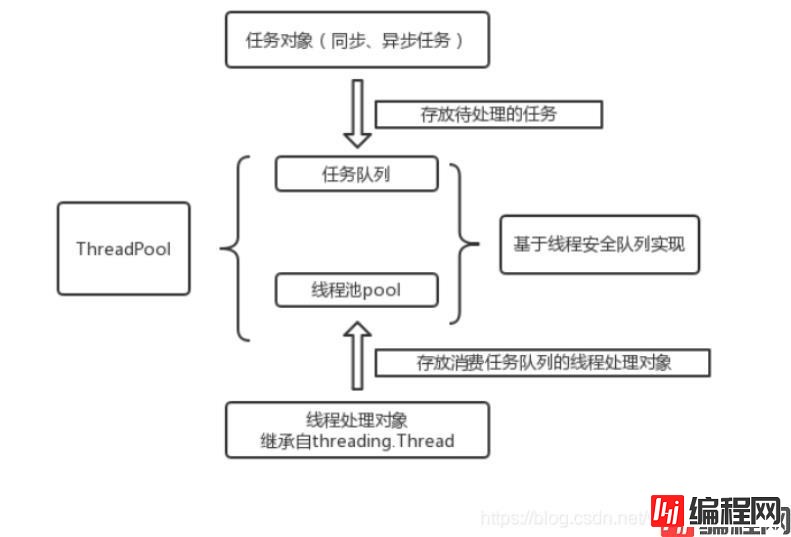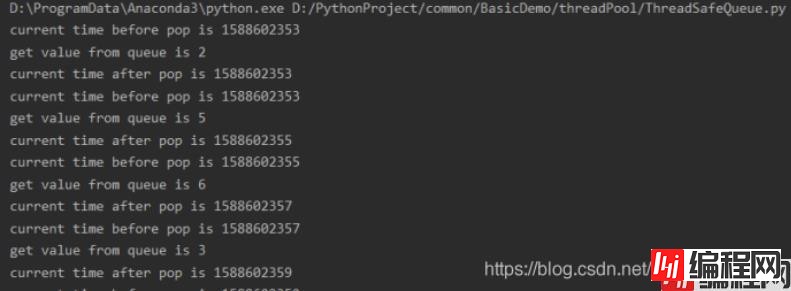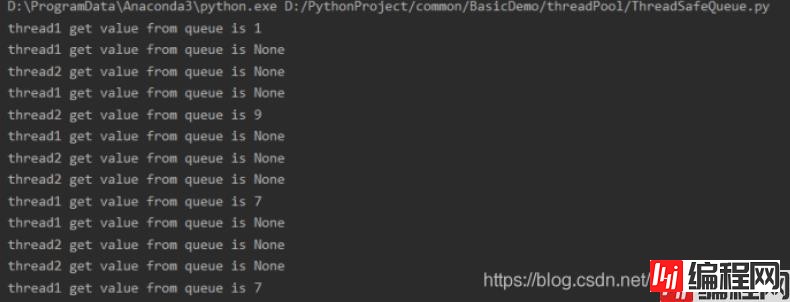Python 官方文档:入门教程 => 点击学习
目录一、线程池组成二、线程安全队列的实现三、测试逻辑3.1、测试阻塞逻辑3.2、测试读写加锁逻辑本文实例为大家分享了python实现线程池之线程安全队列的具体代码,供大家参考,具体内
本文实例为大家分享了python实现线程池之线程安全队列的具体代码,供大家参考,具体内容如下
一个完整的线程池由下面几部分组成,线程安全队列、任务对象、线程处理对象、线程池对象。其中一个线程安全的队列是实现线程池和任务队列的基础,本节我们通过threading包中的互斥量threading.Lock()和条件变量threading.Condition()来实现一个简单的、读取安全的线程队列。

包括put、pop、get等方法,为保证线程安全,读写操作时要添加互斥锁;并且pop操作可以设置等待时间以阻塞当前获取元素的线程,当新元素写入队列时通过条件变量通知解除等待操作。
class ThreadSafeQueue(object):
def __init__(self, max_size=0):
self.queue = []
self.max_size = max_size # max_size为0表示无限大
self.lock = threading.Lock() # 互斥量
self.condition = threading.Condition() # 条件变量
def size(self):
"""
获取当前队列的大小
:return: 队列长度
"""
# 加锁
self.lock.acquire()
size = len(self.queue)
self.lock.release()
return size
def put(self, item):
"""
将单个元素放入队列
:param item:
:return:
"""
# 队列已满 max_size为0表示无限大
if self.max_size != 0 and self.size() >= self.max_size:
return ThreadSafeException()
# 加锁
self.lock.acquire()
self.queue.append(item)
self.lock.release()
self.condition.acquire()
# 通知等待读取的线程
self.condition.notify()
self.condition.release()
return item
def batch_put(self, item_list):
"""
批量添加元素
:param item_list:
:return:
"""
if not isinstance(item_list, list):
item_list = list(item_list)
res = [self.put(item) for item in item_list]
return res
def pop(self, block=False, timeout=0):
"""
从队列头部取出元素
:param block: 是否阻塞线程
:param timeout: 等待时间
:return:
"""
if self.size() == 0:
if block:
self.condition.acquire()
self.condition.wait(timeout)
self.condition.release()
else:
return None
# 加锁
self.lock.acquire()
item = None
if len(self.queue):
item = self.queue.pop()
self.lock.release()
return item
def get(self, index):
"""
获取指定位置的元素
:param index:
:return:
"""
if self.size() == 0 or index >= self.size():
return None
# 加锁
self.lock.acquire()
item = self.queue[index]
self.lock.release()
return item
class ThreadSafeException(Exception):
passdef thread_queue_test_1():
thread_queue = ThreadSafeQueue(10)
def producer():
while True:
thread_queue.put(random.randint(0, 10))
time.sleep(2)
def consumer():
while True:
print('current time before pop is %d' % time.time())
item = thread_queue.pop(block=True, timeout=3)
# item = thread_queue.get(2)
if item is not None:
print('get value from queue is %s' % item)
else:
print(item)
print('current time after pop is %d' % time.time())
t1 = threading.Thread(target=producer)
t2 = threading.Thread(target=consumer)
t1.start()
t2.start()
t1.join()
t2.join()测试结果:
我们可以看到生产者线程每隔2s向队列写入一个元素,消费者线程当无数据时默认阻塞3s。通过执行时间发现消费者线程确实发生了阻塞,当生产者写入数据时结束当前等待操作。

def thread_queue_test_2():
thread_queue = ThreadSafeQueue(10)
def producer():
while True:
thread_queue.put(random.randint(0, 10))
time.sleep(2)
def consumer(name):
while True:
item = thread_queue.pop(block=True, timeout=1)
# item = thread_queue.get(2)
if item is not None:
print('%s get value from queue is %s' % (name, item))
else:
print('%s get value from queue is None' % name)
t1 = threading.Thread(target=producer)
t2 = threading.Thread(target=consumer, args=('thread1',))
t3 = threading.Thread(target=consumer, args=('thread2',))
t1.start()
t2.start()
t3.start()
t1.join()
t2.join()
t3.join()测试结果:
生产者还是每2s生成一个元素写入队列,消费者开启两个线程进行消费,默认阻塞时间为1s,打印结果显示通过加锁确保每次只有一个线程能获取数据,保证了线程读写的安全。

--结束END--
本文标题: Python实现线程池之线程安全队列
本文链接: https://lsjlt.com/news/118354.html(转载时请注明来源链接)
有问题或投稿请发送至: 邮箱/279061341@qq.com QQ/279061341
2024-03-01
2024-03-01
2024-03-01
2024-02-29
2024-02-29
2024-02-29
2024-02-29
2024-02-29
2024-02-29
2024-02-29
回答
回答
回答
回答
回答
回答
回答
回答
回答
回答
0